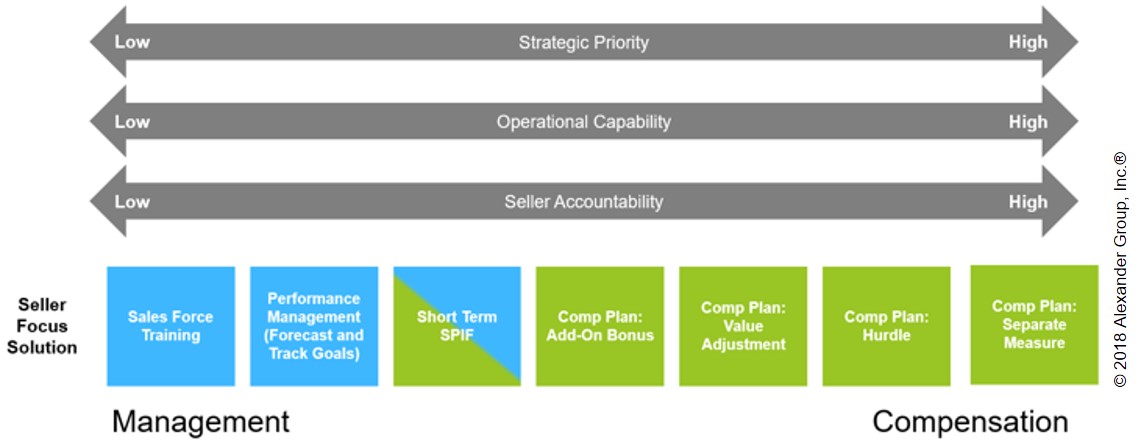Increasing Revenue Capacity, What’s Next?

Media sales organizations across all segments are in a state of strategic reconfiguration. Faced with multiple products and platforms–and advertisers screaming for constant ROI and measurement–media sales companies are scrambling to optimally restructure pre- and post-sales roles to support the new non-linear sales cycle.
Strategy questions during this process might include, Are my ad ops people executing the right tasks? Do we have the right number of traffickers? Can we better integrate DoubleClick for Publishers (DFP) and our CRM? Are we investing enough in creative? Publishers must determine how best to ensure that the front-end and back-end support systems are in tune with upfront sales.
How Media Companies Optimize Sales Support
When discussing how organizations should successfully optimize sales support, consider how media sales strategy leaders can best execute sales reconfiguration. The following three steps outline how media sales organizations can maximize capacity to drive and fulfill customer demand.
1. Align the customer-facing sales organization to current- and future-state strategy
Organizations must align revenue motions, job roles and sales compensation programs to strategy. However, many fail to achieve a successful outcome. For example, an organization may focus on compensation solutions to drive new product focus, while the use of a technical product specialist may yield better results at lower cost. An organization who is just “dabbling” in an offering will need a different approach than an organization that is truly “scaling” an offering. A deeper understanding of market dynamics, expectations and forecasts yields greater organizational readiness. The strategy and organizational readiness dictates the correct approach.
As an example, the chief revenue officer from a leading integrated print company shared that his organization has shifted dramatically to new services (often digital), with the majority of revenue now coming from video, mobile and display [advertising]. Cutting resources alongside shrinking margins have caused shifts in resources. It’s now about putting the incremental pre-sell and post-sale resources on their high-margin business.
2. Drive consistency in pre- and post-sales processes to enable process transparency and workload analyses
Demand for new products means potentially volatile pre- and post-sales workload requirements. To fully realize a strategy and maximize ROI requires support and operational capacity.
Occasionally, task orientation and role accountabilities blur, and informal role definitions and task ownership take over. These “shadow operations” limit accurate process mapping and identification of process bottlenecks. For example, deficits in trafficking capacity may motivate digital ad operations individuals to traffic ads. Identifying inefficient shadow operations and determining pre- and post-sales process bottlenecks will enable prioritization of efficiency generating opportunities.
How much capacity do you really have? How much will new revenue streams cost? Revenue leaders who fail to formalize activities across sales, creative, traffic, ad ops, etc. will limit their ability to diagnose issues to improve processes.
3. Restructure pre- and post-sales roles/processes
Workload demands are spiraling at breakneck speeds, resulting in workload imbalances and capacity constraints. Once an organization understands current capacity, how can it realign resources to manage shifting capacity requirements? Publishers need to innovate: to push new products and solutions. As campaigns grow increasingly complex and straddle multiple platforms, an organization may require project management platforms, or maybe new reporting and optimization platforms are required to deliver on customers’ growing view ability requirements. At the same time, efficiencies gained by increasing focus on programmatic may create capacity, but at lower margins than alternative revenue streams. Organizational investments in headcount and/or product capabilities must be aligned with top- and bottom-line strategies.
Media ad sales organizations are in a state of strategic reconfiguration. As advertisers become more demanding and require data-driven results, the need to align strategy with pre- and post- sales processes and resources is essential to maximize ROI of new revenue streams.
When Pre- and Post-Sales Investments Disappoint
Recently, a national media organization experienced declining sales across core offerings and new digital solutions. The company increased focus on high-margin custom solutions to supplement this decline. Traditional product lines expanded to include SEO, listing support, presence, events, audience extension and XaaS offerings. They hired and trained pre- and post-sales advertising operations personnel with the required skill sets to create appropriate content, increase traffic, optimize campaigns and produce custom reports. Despite hard-fought efforts to optimize the pre- and post-sales processes, a sub-optimal sales model approach left uncaptured returns.
Advertising sales organizations spend time, effort and money optimizing pre- and post-sales processes to support revenue streams. To create demand across new strategic products, companies consider one of the following approaches to drive seller behavior:
- Management: communicate new product goals—forecast, track and manage performance
- Sales compensation: tie incentive payments to strategic product results
The correct choice varies. It hinges on organizational readiness considerations including strategic priority, operational capability and seller accountability.
Strategic priority: Is the offering critical to the success of the organization? Does latent demand exist? Can our sellers realize this demand?
Operational capability: Does the organization have capacity to fulfill against demand? What proportion of capacity is delivering this offering?
Seller accountability: Will sellers need to spend significant time on this offering? What degree of capability do sellers have to deliver the value proposition?
- Management
Driving seller behavior by managing and communicating new product goals mandates that sales leaders forecast goals and track results. Organizational readiness for the offerings is less urgent as publishers are looking to fully determine their ability to meet demands and determine whether sellers are capable of delivering the value proposition. Seller performance is then managed through training and measurement. - Sales Compensation
Sales compensation is not a required tool to drive seller behaviors; it is a choice. Offerings with high levels of organizational readiness warrant consideration of sales compensation solutions. Sales compensation is a tool to drive seller focus on a strategic offering. Multiple options exist for sales compensation solutions ranging from a simple add-on bonus to a separate performance measure, with myriad options of varying complexity in between.
Generating sales productivity
Publishers’ product catalogs are growing in size and complexity; technology and marketing ad innovations fuel supply; publishers drive and respond to demand. Many publishers question both their pre- and post-sales organization’s ability to manage the shifting workloads as well as how their sales models fit within these new strategies. Investing in pre- and post-sales processes does not necessarily generate seller productivity which can result in little to no ROI. To avoid this issue, advertising sales organizations can focus on organizational readiness to respond to new customer demands and better align all sales activities. Continuous communication and performance measurement–and if the publisher is ready, balanced with the right sales compensation solution–will help ad sales organizations achieve a true understanding of seller time, capabilities and motivation to effectively deliver their value proposition.
Media Case Study: Unlocking Hidden Sales Capacity
Integrated media company improves sales efficiency by more than 10% without adjusting headcount.
Media sales organizations and publishers across the spectrum are experiencing evolving workload demands. The required pre- and post-sales work, effort and expertise is constantly shifting. Multiple factors drive these changes:
- Decreased demand for print advertising/publications
- Increased pricing pressure and commodification of traditional digital media
- Constantly evolving technological advancements
- Growing supply of customized campaign solutions, often commanding relatively higher profit margins for publishers
Alexander Group recently partnered with an integrated media company that felt the impact across each of the above dimensions. The company’s sales organization aligned to the new strategy of maintaining traditional print and digital business while driving focus towards high profit, custom solutions. Although custom offerings accounted for only 20% of revenue, Alexander Group found that the proportion of time allocated toward custom offerings across the sales support organization exceeded 50%. With revenue from custom offerings expected to nearly double by 2021, the organization needed to establish clarity around current processes to understand true capacity and avoid potentially overinvesting in the wrong types of resources to handle growing demand.
Capacity issues drove an increase in “Shadow Operations”: task owners pushing accountabilities toward others when assistance was needed and capacity was low. Over time, true role accountabilities became unclear as task orientation and role accountabilities blurred. Processes documented years ago no longer conformed to reality and how things were executed today.
These shadow operations limit accurate process mapping and identification of process bottlenecks. For example, deficits in trafficking capacity may motivate digital ad operations individuals to traffic ads. This can reduce ad operations’ capacity for campaign optimization and reporting, resulting in a misdiagnosed need for additional ad ops resources. Identifying inefficient shadow operations and determining pre- and post-sales process bottlenecks will enable prioritization of efficiency generating opportunities. By standardizing role definitions and eliminating “shadow operations,” Alexander Group found the company could increase capacity by approximately 10% without adjusting headcount.
Demand for new products means potentially volatile pre- and post-sales workload requirements. To fully realize a strategy and maximize ROI requires support and operational capacity. The transition from legacy revenue streams to new and more profitable alternatives may require new sales management and sales compensation program elements. Just as important (if not more) is eliminating shadow operations, driving consistency of process execution and role deployment, and quantifying available capacity. Without a consistent approach and strong understanding of current capacity, it is impossible to understand the capacity requirements to manage and execute against an organization’s future strategy.
Increasing Revenue Capacity, What’s Next?
Establishing clear pre- and post-sales roles is an important step in maximizing organizational revenue-generating capacity. Every opportunity has specific processes required to identify, assess, persuade and fulfill customer demand. Each process requires a certain amount of time and energy, which are often in short supply. Once pre- and post-sales workload capacity is quantified, media sales organizations can take steps to identify and prioritize the most impactful initiatives to generate efficiency and increase capacity.
Most media organizations with print and digital offerings face increasing pricing pressure and decreased demand across product lines. As revenue from transactional business declines, these media firms need to find ways to optimize focus on profitable offerings that often have complex and volatile fulfillment requirements.
Contact us today to learn how Alexander Group’s Media team can assist you with sales reconfiguration and with the development of a 9-, 12- and 24-month roadmap for designing optimal sales support processes to enable revenue growth.
